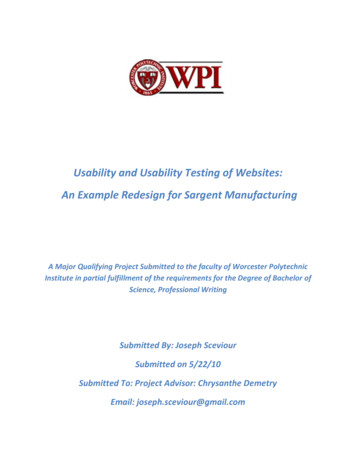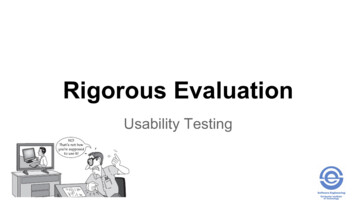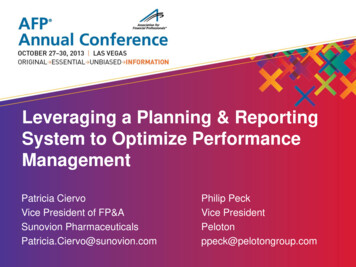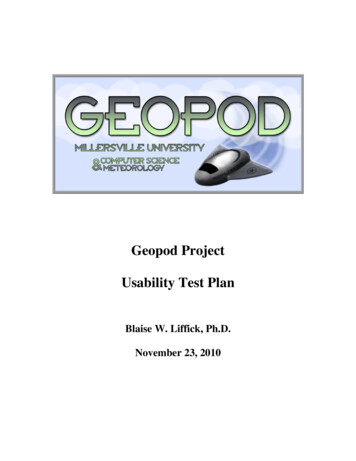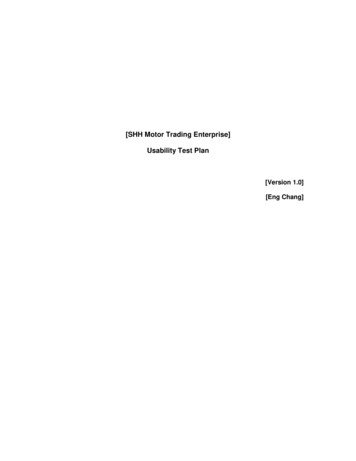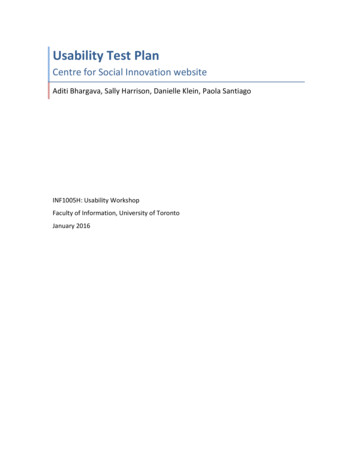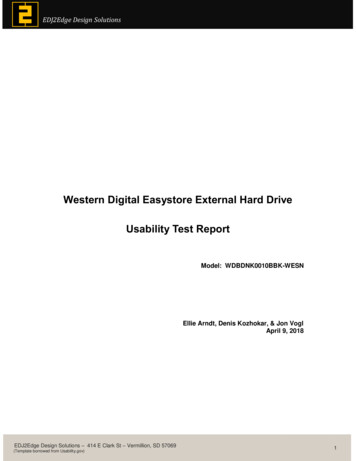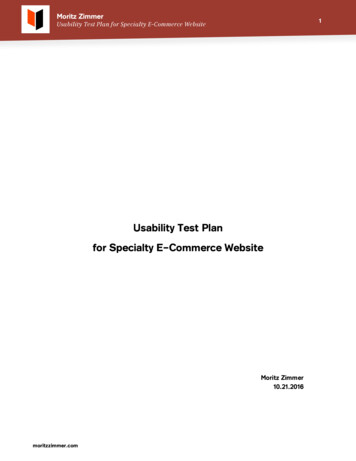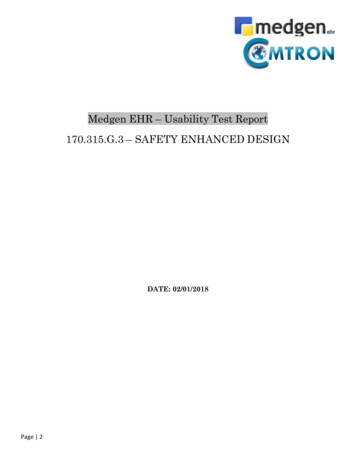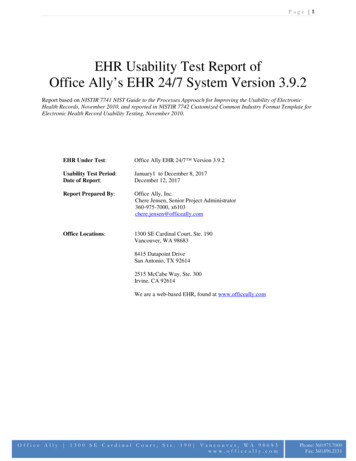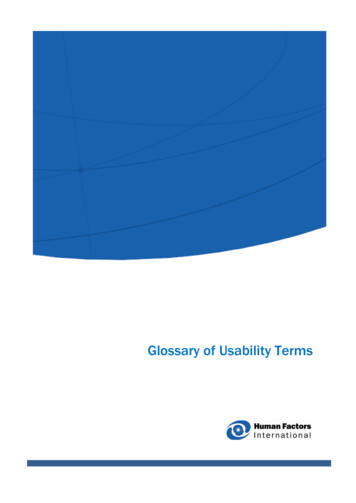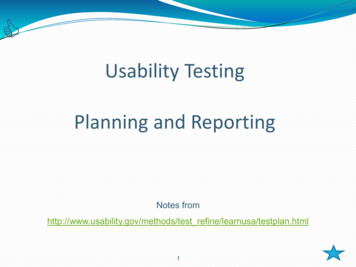
Transcription
Usability TestingPlanning and ReportingNotes fromhttp://www.usability.gov/methods/test refine/learnusa/testplan.html1
Learning objectives Be able to develop usability testing plans Be able to write usability test reports Understand the nature of human research ethicsrequirements when conducting studies on humansUsability Evaluations2
Plan EVERYTHING Use a template such as athttp://www.usability.gov/methods/test refine/learnusa/testplan.html Fill in ALL the bits – even those that are completelyobvious Take the position that you are planning the test for 5other people to do, each is in a different part of theworld. To be useful all the participants must have thesame experience.
Details Product under test Exactly what and how is it going to be testedinclude (as relevant) version numbers etc. Test Objectives What’s the goal? What are you planning to measure Participants How many and what times of people are to berecruited? Equipment Be specific, eg for desktop specify OS, screen, processor, UI devices.For web specify device, browse.
Details continued Test Tasks Must be detailed and fully described (and tested).See next slide Test Procedure Full details see later Data to be collected Be specific Data Analysis Plan Be specific - test it out.Usability Evaluations5
Participants Generally it is better if people can be themselves. Occasionally you need people to role-play Try to match age, gender and things like first languageto the target audience How many? 10-12 will generally give you good results for a singleproduct 30 if comparing products and you want statisticallyvalid results.Usability Evaluations6
Task Selection Utterly central to what you will learn in the usabilitytest There just isn’t time / resources to do usability testingon everything Select the tasks that are ‘make-or-break’ for theapplication You’re looking for the risk What’s novel? What will differentiate this product? If you’re in a ‘safe’ zone where you’re emulating well-established interaction patterns, then you’ll learn less Then again, still can be important to check that you got it right!Usability Evaluations7
Task Design Be specific* “enrol in COMPSCI345 at the University of Auckland” “what lecture room(s) are COMPSCI345 lectures in?” Record Completion Paths Step through the task yourself Record different routes to successfully completeTime yourself Note things you think are difficult or confusing You are, in effect doing a Heuristic Evaluation (assignment 1 is prettymuch this with thorough documentation) Remember these are notoriously inaccurate (users will surpriseyou) Do not show these to participants* See next slide
Task Order For you assignment you need to think carefully abouttask order. Do you want to fix the order – eg everyone does cash,then credit card then txt Do you want to ‘latin square’ – eg every variation oforder (there are six) What do you think the difference would be? This is called the learning effect.Usability Evaluations9
Questionnaire The easiest way to gather satisfaction data is aquestionnaire There are several ‘standard’ questionnaires pt.doc #posttest
Questionnaire – open and closed Open questions (as per previous slide) give you richqualitative data Best for finding the seeds of resolutions to problems Closed questions allow you to quantify Would you recommend this website to a friend? [Circle one] YESNO Yes/No is OK, but better to use Likert scale This website is easy to use: Strongly Agree Agree Disagree Strongly Disagree Converts to scores (1-4, 1-7, etc.), can report mean andother statistics and graphs There’s a whole world to writing questionnaires; starter:http://www.terry.uga.edu/ rgrover/chapter 5.pdfUsability Evaluations11
Procedures Don’t under-estimate the practical problems If you get something wrong you can lose a lot of time(and, in most situations, money) having to reschedule Running a pilot or walkthrough can help here Have you figured out How to pay / reward participants? Any catering for longer session (including your staff ifthe experiment is in the ‘field’)? Do you have enough power points and battery life? Enough storage capacity (e.g. on your digital camera)? The time and ability to ‘reset’ in between participants?Usability Evaluations12
Details (not on that sample template!) Analysis plan How are you going to turn the raw observations intoassessment against your usability requirements, and intorecommendations? It’s one thing to declare ‘time’ as a metric and plan tocollect video, but have you defined exactly whichelements of the task you are timing, and the protocol formarking the task time? Is your method practical and accurate? Will it support theoverall purpose of your usability test What is your plan for how to report the findings What, to whom, when and toward what follow-up action?Usability Evaluations13
Half time entertainment https://www.youtube.com/watch?v 3Qg80qTfzgUUsability Evaluations14
Back to the test plan Write a Script Script the usability study EXACTLY Greeting Ethics Task instructions Questionnaire If you don’t have a script you WILL get lazy and missinstructions for later participants.
Data Collection Metrics What will you measure/collect VideoErrorsTimeObservationsQuestionnaire How many people do you need during tests? Participant guideObserver
Analyse Results Task time and success Errors – you’ll want counts and to form categories Wrong navigation Problems finding particular features . Questionnaire analysis If around 10 people or less, show raw data, mean andstandard deviation If more than 10 people, box plots or frequencydistribution graphs might be appropriate
Pilot Test Try the whole thing out on one or two people (or moreif it’s a really important and large usability study) After first person fix obvious problems If very few corrections needed in test plan then you cango straight to testing But it is much better to do a second pilot than discovermajor problems half way through
Analyse Summarize information into tables Use numbers where you can Classify comments into groups Run statistics as appropriateUsability Evaluations19
Think! The big picture What have you found? What is worth fixing? Is there a business case? How could the problems bealleviated?
Report Document Detailed report of everything you have found Three formats here ber numbers are very convincing, compare: Several people had trouble finding the shopping basket 3 out of 7 people abandoned the task because they couldn’t findthe shopping basket. For the other 4 the average time to find theshopping basket was 3.59seconds (longest 8.0 seconds) Video Imagine clipping together the 7 people looking for theshopping basket icon with puzzled looks on their faces!
Ethics If you are doing a study with living (human or animal)participants in a university you will probably needethics approval Can be quite a lot of paperwork, and takes a while to getan answer (which is usually to revise and re-submit!) You will need such approval for a study to be part of yourdissertation or thesis Many journals require such approval to publish Quite a few companies have similar requirements This is why for your assignment you are not testing onothers – though you could ask classmates
Research ethics basics Informed consent Participant knows what they are ‘in for’ Task, time, why you’re doing it (even though you may be allowedto ‘deceive’ them about some aspect of the task)Confidentiality of their dataCompensation (if any) Participant is clear that they are not compelled toparticipate This is a bit of a trick in lecturers experimenting on their students!(or doctors on patients, or bosses on their employees) They need to know that they can refuse, or withdraw (evenretrospectively!) without jeopardising the key service (healthcare,education, employment) Anonymous questionnaires, esp. in public, are probably theeasiest from an ethics perspectiveUsability Evaluations23
Ethics application Explains protocol and goals: essentially like a test plan And so it’s helpful to complete one because it acts as acheck on your plan Particular focus on issues such as who has access to thedata and the risk (and benefits, if any) to participants Research organisations (University, District HealthBoard) have standing committees to reviewapplications Have representatives from a range of perspectives:clinical, legal, statistical (and Maori in NZ)Usability Evaluations24
Professionalism Treat participants with respect Assume they are not idiots, it is the software that iswrong Treat developers with respect They may have put their heart and soul into the productand worked overtime to get if finished for you to pull itapart Make sure your report is Fair and accurate Tidy Free from grammar and spelling errors
In the real world If you can’t do a ‘real’ usability test Get your mates, Mum, Dad, Aunty Flo to try it Tune-in to your own usability experiences Note what was really easy that’s a sign of good usability Note what is annoying you Note when you are trying to do something you havedone before and can’t remember how.
Summary Evaluate usability early and often in development and[preferably staged] roll-out Also evaluate alternatives before making a decision topurchase/adopt a system You need a complete and detailed testing plan Heuristic evaluation is a handy intermediate levelbetween just asking a couple people for feedback anddoing a full-blown usability studyUsability Evaluations27
(noton that sample template!) Analysis plan How are you going to turn the raw observations into assessment against your usability requirements, and into recommendations? t’s one thing to declare ‘time’ as a metric and plan to collect video, but have you defined exactly which elements of the task you are timing, and the protocol for
